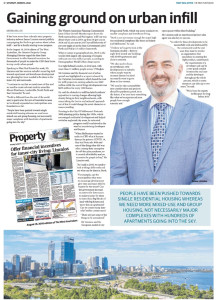
It has been more than a decade since property industry stalwart James Limnios started publicly ‘campaigning for Perth to get serious about urban infill – and he is finally starting to see progress.
In the August 18, 2010 edition of The West Australian, the Limnios Property Group ‘Managing Director urged the then State Government to offer financial incentives for thousands of people to make the CBD their home to stop costly urban sprawl.
Speaking to West Real Estate this week, Mr Limnios said the western suburbs’ recent big shift towards apartment and townhouse development was pleasing but more needed to be done in the inner city and surrounds.
“I continue to say that we need more of this and we need to create relevant stock in areas like Mount Hawthorn, Leederville, North Perth and East Fremantle”, he said.
“Perth is different from the rest of the world and, in particular, the rest of Australia because we’ve already expanded our metropolitan area boundaries so far.
“People have been pushed towards single residential housing whereas we need more ‘mixed-use and group housing, not necessarily major complexes with hundreds of apartments going into the sky.”
The Western Australian Planning Commission’s latest Urban Growth Monitor report shows the Perth metropolitan and Peel regions’ infill rate was about 43 per cent in 2019, up from 38 per cent in 2018 and 42 per cent in 2017 but still below the 47 per cent target set in the State Government’s 2018 Perth and Peel @ 3.5 million framework.
When it comes to geographical size, Perth is the ‘world’s 64th largest city, spanning 1722sqkm with just over two million people, according to Demographia’s World Urban Areas report.
It is right behind London, in 63rd spot, with more than 11 million people across 1738sqkm.

The Perth coastline stretches from Mandurah in the south to Yanchep in the north. (ABC Radio Perth: Lorraine Horsley)
Mr Limnios said the financial cost of urban sprawl was highlighted in a report released by the Victorian Government, which found the cost for infill projects in existing suburbs was $309 million while the cost of fringe developments was ‘$653 million for every 1000 homes.
He said the obstacles to infill included residents’ ‘opposition to zoning changes allowing high density living in their neighbourhoods, with many taking the ‘not in my backyard’ approach ‘out of fear it could change the areas character or cause crowding.
Pointing to the City Of Melbourne’ Postcode 3000 planning policy during the 1990s, which encouraged residential development and helped revitalise neglected city areas, he reiterated progress could be achieved in the west be incentivizing developers and buyers.
“When Melbourne wanted to make its CBD what it became famous for prior to COVID-19, they had Postcode 3000 and one of the things they did was offer a stamp duty exemption for off-the-plan purchases, so it created affordability and an incentive for people to buy” Mr Limnios said.
“As I said in 2010, we need to look at things differently and see what can be done in Perth.
“For example, can the ‘municipalities that want to encourage development give rates and taxes relief to buyers for two years? Can the government increase incentives for downsizers
to make it easier for them to leave those big blocks of land with big houses and move into an apartment? Can we create stamp duty relief within certain areas?
“These are just some of the things to be considered.”
Mr Limnios said the European model of city living suited Perth, which was more conducive to smaller complexes and townhouse living.
“Perth is not yet mature enough for major high: rise residential complexes like those in Sydney and Melbourne,” he said.
“I believe we’ve got to look at the European models – three to eight-level mixed-use buildings with 40-60 apartments and close to amenity.
“We also need to focus ‘on townhouse-style developments in suburbs where people want to
increase density but don’t necessarily want to go to three or four storeys.
“We need to take sustainability into consideration and projects should be pandemic proof, so in the future, if we ever have something like what we’ve experienced now, people have enough amenity and ‘open spaces within their building”
Mr Limnios said an experienced project sales agent was also key to success.
“In order for these developments to be successfully sold and embraced by the community and the end user, they need to involve an organisation that specialises in creating the right product, understands the requirements of a developer and can be a very good conduit between the end user and the developer throughout the whole process, which in some instances can take up to two years,” he said.
“We’ve been the experts in this space for long before 2010″.


